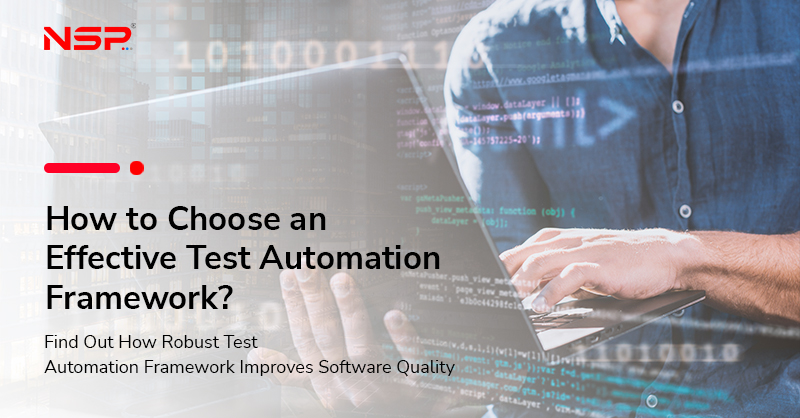AI – driven process automation
admin
October 23, 2023
Artificial Intelligence
In today's fast-paced world, where technology is emerging at an unprecedented rate, industries are constantly seeking ways to improve their efficiency, productivity, and safety measures. This has led to the emergence of AI-driven predictive maintenance as a game-changing solution.
By harnessing out IoT Platform, NS Envision, the ultimate power of artificial intelligence and data analytics, businesses can now not only detect potential equipment failures before they occur but also optimize maintenance schedules and reduce downtime.
Understanding Predictive Maintenance
Before delving into the intricacies of AI-driven predictive maintenance, it's important to grasp the fundamentals of predictive maintenance itself. Predictive maintenance is a proactive approach aimed at identifying and addressing potential equipment failures before they happen. By using historical data, sensor readings, and advanced algorithms, predictive maintenance systems can predict when a component is likely to malfunction, enabling maintenance teams to intervene before it leads to a costly breakdown.
Predictive maintenance goes beyond traditional reactive and preventive maintenance strategies. While reactive maintenance involves fixing equipment after it has failed and preventive maintenance involves scheduled maintenance regardless of the equipment's condition, predictive maintenance takes a more data-driven and targeted approach. It leverages the power of technology and analytics to monitor equipment health in real-time, allowing for timely interventions and optimized maintenance schedules.
The Basics of Predictive Maintenance
At its core, predictive maintenance relies on collecting and analysing data from various sources to identify patterns and anomalies. By monitoring equipment condition, performance, and environmental factors, predictive maintenance systems can detect early signs of degradation or failure. This proactive approach allows businesses to schedule maintenance activities when they are most convenient, minimizing disruption to operations.
Implementing a predictive maintenance strategy involves several key steps. First, data collection is crucial. This includes gathering historical data, such as maintenance records, equipment performance data, and sensor readings. Additionally, real-time data from sensors and IoT devices provides valuable insights into the current condition of the equipment. Once the data is collected, it needs to be processed and analyzed using advanced algorithms and machine learning techniques. This analysis helps identify patterns, correlations, and anomalies that can indicate potential failures or performance issues.
Furthermore, predictive maintenance systems can generate alerts and notifications when certain thresholds or conditions are met. These alerts can be sent to maintenance teams, enabling them to take immediate action. By addressing issues proactively, businesses can minimize downtime, optimize maintenance costs, and ensure the smooth operation of critical equipment.
The Role of Predictive Maintenance in Industries
The importance of predictive maintenance cannot be overstated. In industries such as manufacturing, transportation, and energy, where downtime can have significant repercussions, the ability to anticipate and prevent equipment failures is paramount. Predictive maintenance not only helps in reducing the risk of costly breakdowns but also increases the lifespan of assets, reduces maintenance costs, and improves overall operational efficiency.
In the manufacturing sector, for example, predictive maintenance can prevent unplanned downtime that can result in production delays and lost revenue. By continuously monitoring equipment health and performance, manufacturers can identify potential issues before they escalate, allowing for timely repairs or replacements. This proactive approach ensures that production lines run smoothly, minimizing disruptions and maximizing productivity.
[Image of predictive maintenance in manufacturing]
In the transportation industry, predictive maintenance plays a crucial role in ensuring the safety and reliability of vehicles. By monitoring critical components like engines, brakes, and transmissions, predictive maintenance systems can detect early signs of wear or malfunction. This enables transportation companies to schedule maintenance activities during planned downtime, reducing the risk of breakdowns on the road and improving passenger safety.
[Image of predictive maintenance in transportation industry]
Similarly, in the energy sector, predictive maintenance helps optimize the performance of power generation and distribution systems. By monitoring equipment health and identifying potential failures in advance, energy companies can minimize the risk of power outages and ensure a stable supply of electricity. This not only improves customer satisfaction but also reduces maintenance costs and extends the lifespan of expensive assets.
[Image of predictive maintenance in Energy sector]
Overall, predictive maintenance is a powerful tool that empowers businesses to take a proactive approach to equipment maintenance. By leveraging data and advanced analytics, companies can avoid costly breakdowns, optimize maintenance activities, and enhance operational efficiency across various industries.
The Emergence of AI in Predictive Maintenance
As technology continues to advance, the integration of artificial intelligence (AI) into predictive maintenance has become a game-changer. AI enables systems to learn from historical data and make accurate predictions, enhancing the effectiveness of predictive maintenance strategies.
Predictive maintenance, also known as condition-based maintenance, is a proactive approach to maintenance that aims to identify and address potential issues before they cause equipment failures. Traditionally, this process has relied on manual inspections, scheduled maintenance, and periodic data analysis. However, with the emergence of AI, predictive maintenance has taken a significant leap forward.
The Intersection of AI and Predictive Maintenance
AI and predictive maintenance are a match made in heaven. By leveraging machine learning algorithms, analyze massive amounts of data in real-time, identifying trends, anomalies and patterns that may go unnoticed by humans. This allows businesses to detect subtle changes in equipment behavior that could be early indicators of imminent failures.
Imagine a manufacturing plant with hundreds of machines operating simultaneously. Each machine generates a vast amount of data, including temperature, pressure, vibration, and other sensor readings.
Analyzing this data manually would be an overwhelming task for maintenance teams. However, with AI, these teams can harness the power of machine learning to automate the analysis process and identify potential issues with ease.
How AI Enhances Predictive Maintenance?
AI takes predictive maintenance to a whole new level. By continuously learning from new data and refining its algorithms, AI systems can improve their predictive accuracy over time. This means that maintenance teams can make data-driven decisions based on precise predictions, optimizing maintenance schedules, and reducing the risk of unexpected breakdowns.
Moreover, AI can also help maintenance teams prioritize their tasks. By analyzing the data, AI systems can assign a priority level to each potential issue, allowing teams to focus on the most critical problems first. This not only improves efficiency but also ensures that resources are allocated effectively.
Another advantage of AI in predictive maintenance is the ability to detect patterns and anomalies that may not be apparent to human operators. With AI algorithms continuously monitoring the equipment's performance, it can identify subtle deviations from normal behavior that could indicate underlying issues. By catching these deviations early on, maintenance teams can take proactive measures to prevent failures and minimize downtime.
In addition to these benefits, AI can also help optimize maintenance schedules. Traditional maintenance approaches often rely on fixed schedules, such as periodic inspections or routine replacements. However, this can lead to unnecessary maintenance and increased costs. With AI, maintenance schedules can be tailored based on the actual condition of the equipment, maximizing its lifespan and minimizing downtime.
Overall, the integration of AI into predictive maintenance has revolutionized the way businesses approach equipment maintenance. By leveraging the power of machine learning and real-time data analysis, AI systems enable businesses to detect and address potential issues before they escalate into costly failures. As technology continues to advance, the future of predictive maintenance looks brighter than ever with AI at its core.
Benefits of AI-Driven Predictive Maintenance
The advantages of adopting AI-driven predictive maintenance are manifold, revolutionizing the way businesses approach maintenance activities and operations.
AI-driven predictive maintenance goes beyond traditional reactive and preventive maintenance approaches. By leveraging advanced analytics and machine learning algorithms, it enables businesses to predict and prevent equipment failures before they occur. This proactive approach offers a range of benefits that have a significant impact on business operations and outcomes.
Increased Efficiency and Productivity
By detecting and resolving potential equipment failures before they occur, AI-driven predictive maintenance significantly reduces unplanned downtime. This ensures that machinery and assets are operating at peak performance levels, maximizing overall efficiency and productivity.
With AI-driven predictive maintenance, businesses can optimize maintenance schedules based on real-time data and equipment condition. This eliminates the need for unnecessary maintenance activities and reduces the risk of over-maintenance. As a result, resources can be allocated more efficiently, allowing employees to focus on other critical tasks and improving overall productivity.
Cost Savings and ROI
AI-driven predictive maintenance is not only a proactive but also a cost-effective solution. By optimizing maintenance schedules and avoiding costly breakdowns, businesses can save on repair and replacement expenses.
Moreover, AI-driven predictive maintenance helps businesses extend the lifespan of their equipment. By identifying and addressing potential issues early on, businesses can prevent major breakdowns that may require expensive repairs or even the replacement of entire systems. This leads to significant cost savings in the long run.
Additionally, the increased efficiency and productivity resulting from AI-driven maintenance lead to higher returns on investment. With improved equipment performance and reduced downtime, businesses can meet production targets more consistently and deliver products or services to customers more effectively, ultimately driving revenue growth.
Improved Safety Measures
Ensuring the safety of employees and assets is of paramount importance in any industry. By proactively addressing equipment failures, AI-driven predictive maintenance minimizes the risk of accidents caused by faulty or malfunctioning machinery.
With AI-driven predictive maintenance, businesses can continuously monitor the condition of their equipment and receive real-time alerts about potential failures or safety hazards. This allows them to take immediate action to rectify the situation and prevent accidents from occurring. By creating a safer work environment, AI-driven predictive maintenance reduces the chances of injuries or even fatalities, safeguarding the well-being of employees and protecting the company's reputation.
In conclusion, AI-driven predictive maintenance offers numerous benefits that go beyond traditional maintenance approaches. From increased efficiency and productivity to cost savings and improved safety measures, businesses can leverage AI technologies to optimize their maintenance strategies and achieve better operational outcomes.
Real-World Applications of AI-Driven Predictive Maintenance
AI-driven predictive maintenance has demonstrated its prowess across various industries, transforming the way maintenance is approached.
AI in Manufacturing Maintenance
In manufacturing, machine downtime can lead to significant financial losses. AI-driven predictive maintenance aids in preventing unexpected breakdowns, allowing manufacturers to maintain uninterrupted production. By constantly monitoring equipment health and performance, manufacturers can identify areas where preventive maintenance can have the greatest impact.
AI in Transportation Maintenance
The transportation industry heavily relies on various modes of transportation, including vehicles, trains, and planes. Predicting and preventing equipment failures is crucial to ensure smooth operations. By utilizing AI-driven predictive maintenance, transportation companies can minimize delays, reduce maintenance costs, and enhance passenger safety.
AI in Energy Sector Maintenance
In the energy sector, where downtime can lead to significant economic losses and even widespread outages, AI-driven predictive maintenance plays a critical role. By continuously monitoring equipment condition and performance, AI systems can optimize maintenance schedules and minimize the risk of costly failures. This results in improved reliability, increased operational efficiency, and better resource utilization.
Challenges and Limitations of AI-Driven Predictive Maintenance
While AI-driven predictive maintenance offers numerous benefits, it is not without its challenges and limitations.
- Data Quality and Quantity Issues
Accurate predictions in AI-driven predictive maintenance require a vast amount of high-quality data. Obtaining such data can be a challenge, especially for older equipment or industries with limited historical data available. Additionally, ensuring that the collected data is accurate and reliable is crucial for the effectiveness of predictive maintenance systems.
- Need for Skilled Personnel
Implementing and maintaining AI-driven predictive maintenance systems requires specialized knowledge and expertise. From data scientists and engineers to maintenance professionals, businesses need a skilled team to implement and manage these systems effectively.
- Technological and Infrastructure Challenges
Embracing AI-driven predictive maintenance often requires significant technological upgrades and infrastructure investments. Integrating AI systems with existing machinery, sensors, and data collection devices can be complex and costly. It may also require training personnel to use and interpret the insights provided by the AI systems effectively.
In conclusion, AI-driven predictive maintenance is poised to revolutionize the maintenance industry. By harnessing the power of artificial intelligence and data analytics, businesses can anticipate and prevent equipment failures, increase operational efficiency, and ensure the safety of employees and assets. While there are challenges and limitations to overcome, the benefits far outweigh the drawbacks. As technology continues to advance, AI-driven predictive maintenance will undoubtedly be the future of maintenance in various industries. Reach out to us at reachus@nsplustech.com to enable our AI predictive maintenance for your operations and achieve the above benefits and resolve the challenge of your business units.
Previous Post
2023-2030 manufacturing applied technologies trends to watch
Recent News artical
Fresh job related news content posted each day

October 23, 2023
Digital Transformation as a service
Today Digital Transformation As a Service (DXaaS) is a popular choice for...
Read more
October 23, 2023
Securing financial services: Role of MFA Verification
As per the projections, cybercrime is predicted to cost the global economy...
Read more
October 23, 2023
How to choose an effective test automation framework?
In today's fast-paced software development industry, having a reliable and efficient automation...
Read more